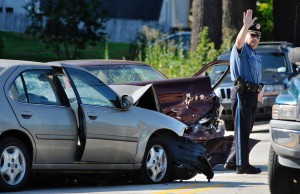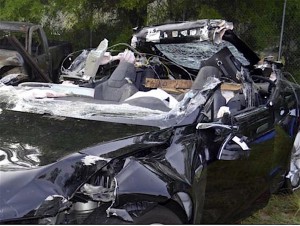
Motor vehicle deaths are expected to rise 9% for the first six months of 2016: A nearly three-year trend.
The death toll on American roads and highways continues to rise as new estimates show a 9% jump in motor vehicle deaths through the first six months of 2016, according the National Safety Council.
An estimated 19,100 people have been killed and 2.2 million seriously injured compared with the same period in 2015. The figure is 18% higher than 2014 results. The deaths not only extract a toll on the impacted families, but the estimated financial cost is $205 billion.
“Our complacency is killing us,” said Deborah A.P. Hersman, president and CEO of the National Safety Council. “One hundred deaths every day should outrage us. Americans should demand change to prioritize safety actions and protect ourselves from one of the leading causes of preventable death.”
The upward trend began in late 2014 and despite the introduction of stronger, safer vehicles laden with more safety technology than ever, it appears to show no sign of decreasing. Last winter, the NSC issued its largest year-over-year percentage increase in 50 years, when it estimated fatalities had jumped 8% in 2015 compared to 2014.
The warning comes now as the country heads into one of the busiest weekends for holiday travel: Labor Day weekend. The group estimates that more than 435 people will be killed during the extended holiday weekend. If that prediction comes true, it will be highest numbers since 2008, officials said.
(Holiday weekend may be the deadliest on record. For more, Click Here.)
States that have been particularly hard hit since 2014, the start of the upward trend, are Florida (43%), Georgia (34%), Indiana (33%), California (31%), North Carolina (26%), Illinois (24%) and Kentucky (24%).

Smarter, safer and more technologically advanced vehicles may be giving drivers a false sense of security.
Not surprisingly, Americans are racking up miles at record levels, logging 3.148 trillion miles behind the wheel, according to data from the Federal Highway Administration. Exactly why Americans are driving more is unclear, however, FHA spokesman Doug Hecox told the Minneapolis Star Tribune earlier this year, “We just know there are more cars out there and they’re going farther.”
However, there are some factors that shed some light on why, such as a stronger economy and lower unemployment rates. However, the biggest factor is likely the price of gas. Average gas prices for the first six months of this year were 16% lower than 2015 levels, helping to fuel a 3.3% increase in the number of miles driven.
(Click Here for details about the rise in pedestrian deaths in the U.S. last year.)
Road travel has also seen significant improvements, fatalities dropping 40% since the 1970s peak. But NHTSA’s Mark Rosekind told TheDetroitBureau.com that the agency’s goal is to get the figure down to zero.
Several automakers, including Nissan and Volvo, have set similar goals, and the industry, on the whole, has become more proactive on the subject. A new safety consortium pairing NHTSA and 18 major automakers was announced earlier this year during the Detroit Auto Show. The goal is to push new technologies into production faster than might otherwise happen through the traditional regulatory process.
A study by the Insurance Institute for Highway Safety last week found that forward collision warning systems were cutting the number of rear-end crashes reported to police by 23%. More advanced autonomous emergency braking systems delivered a 40% reduction.
But such technologies will take decades to roll out across the vast U.S. fleet, proponents note, considering the average vehicle on the road is now 11 years old. That leaves safety proponents and regulators struggling to find ways to reverse last year’s unexpected upturn in fatalities.
(U.S. highway fatalities surge 8% in 2015. Click Here for the story.)
To help ensure safety, the National Safety Council recommends drivers make sure every passenger buckles up on every trip. The group also suggest drivers avoid alcohol, get plenty of sleep the night before a trip, avoid cell phone usage and keep a trained eye on teenage drivers.

The answer to what is causing the increase is obvious to anyone who spends time on the roads. It is not speed, it is not the elderly, it is not the young. It is cell phones! If your cell phone was made inoperable when the vehicle’s emergency brake is not engaged, traffic deaths would plummet
Are more people driving without licenses or impaired? What effect does distracted driving have on these numbers? In my area, SW Michigan, these seem to be relatively common causes in serious and fatal crashes.
The increase is economic. The recession years depressed driving, in particular DUI, younger drivers, and less discretionary (travel) driving.
The last boom year (not counting 2015), was 2007, where then we drove a record number of miles.
http://www-fars.nhtsa.dot.gov/Main/index.aspx
In the 2007 US deaths were 41,259 which was at the time the biggest driving year till 2015.
2015 deaths are LOWER! And if the 19,100 6 months number, will be lower than 2007 despite even more miles driven than 2015 in 2016.
It is really important to NOT compare 2016 or 2015 to the recession years as any comparison to 2008 to 2014 numbers SKEW the results due the recession affecting the numbers.
Here are 2006 thur 2014.
http://www-fars.nhtsa.dot.gov/Main/index.aspx
2006 US Death rate per mile 1.42 Total Deaths 42,708 Miles Driven 3.014 Trillion (3,014 VMT Billion)
2007 US Death rate per mile 1.36 Total Deaths 41,259 Miles Driven 3.031 Trillion
Recession Begins
2008 US Death rate per mile 1.26 Total deaths 37,423. Miles Driven 2.977 Trillion (2,977 VMT Billion)
Full year of recession
2009 US Death rate per mile 1.15 Total deaths 33,883. Miles Driven 2.957 Trillion
2010 US Death rate per mile 1.11 Total deaths 32,999. Miles Driven 2.967 Trillion
2011 US Death rate per mile 1.10 Total deaths 32,479. Miles Driven 2.950 Trillion
2012 US Death rate per mile 1.14 Total deaths 33,782. Miles Driven 2.969 Trillion
2013 US Death rate per mile 1.10 Total deaths 32,894. Miles Driven 2,988 Trillion
Starting to leave Recession
2014 US Death rate per mile 1.08 Total deaths 32,675. Miles Driven 3.026 Trillion (3,026 VMT Billion)
Also note that a lot of the deaths in places like AL had a high percentage of people NOT WEARING seat belts too. Couple that with more miles, more likely DUI and younger drivers, that is why it is higher also than the recession years.
Also it would be helpful if NSC would also use the DEATH RATE per mile as it takes into account the miles driven too. 2015 was 1.12, thought higher than 2014 and 2013, was lower than 2012.
Again we are dealing with an economic increase and the effects of that. When the next recession hits, and DUI, younger drivers, and discretionary driving drops so will the deaths.